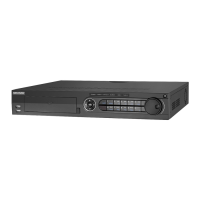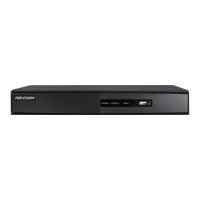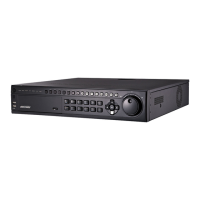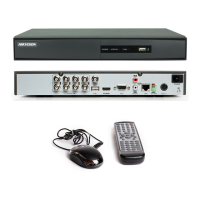

Do you have a question about the HIKVISION DS-7200 Series and is the answer not in the manual?
| Operating Humidity | 10% to 90% |
|---|---|
| Video Input | 4/8/16 channels |
| Video Output | 1 × VGA, 1 × HDMI |
| Compression | H.264+/H.264 |
| Network Interface | 1 RJ45 10M/100M self-adaptive Ethernet interface |
| Audio Output | 1 channel |
| USB Interface | 2 USB 2.0 |
| Alarm Input | 4/8/16 channels (varies by model) |
| Operating Temperature | -10 °C to 55 °C (14 °F to 131 °F) |
Sets transmission stream type, resolution, bitrate, and other video recording parameters for analog and IP cameras.
Details how to set up recording schedules for different cameras, including types like continuous, motion, and VCA.
Guides on enabling motion detection, drawing areas, setting sensitivity, and configuring triggered recording actions.
Explains how to set up recording triggered by alarm inputs, including channel selection and schedule configuration.
Covers setting up VCA events like line crossing, intrusion, and face detection for triggered recording actions.
Details how to manually start and stop recording, which takes priority over scheduled recordings.
Allows setting different recording plans for holidays, separate from the regular daily schedule.
Explains how to enable redundant recording to save files on a secondary HDD for enhanced data safety and reliability.
Describes managing HDDs in groups to record files onto specific HDD groups, enhancing storage organization.
Covers locking recorded files or setting HDDs to read-only to prevent data overwriting and protect important recordings.
Configures motion detection parameters, including area, sensitivity, trigger channels, and arming schedules.
Details how to set up handling methods for external sensor alarms, including trigger channels and schedules.
Explains how to detect video loss from a channel and configure associated alarm response actions.
Covers setting up detection for video tampering (lens covered) and configuring response actions.
Guides on configuring VCA events like line crossing, intrusion, and face detection for alarm triggers.
Details how to configure responses for various device exceptions like HDD errors, network disconnections, and IP conflicts.
Configures how the system reacts to alarms, including full-screen monitoring, audible warnings, and email notifications.
Explains how to manually trigger or clear alarm outputs for testing or specific operational needs.
Guides on initializing newly installed HDDs before they can be used by the device.
Details adding and configuring NAS or IP SAN storage as network HDDs for expanded storage capacity.
Explains how to manage multiple HDDs in groups for organized recording and storage management.
Sets HDD properties like redundancy, read-only, or read/write (R/W) for data safety and reliability.
Allocates specific storage quotas for recorded files on a per-camera basis to manage disk space effectively.
Monitors the status of installed HDDs for potential failures and the need for immediate maintenance.
Utilizes Self-Monitoring, Analysis, and Reporting Technology to detect potential HDD failures and assess reliability.
Scans for bad sectors on HDDs that can slow down system performance and takes measures to repair them.
Sets up alarms for HDD errors or abnormal statuses, triggering notifications for timely intervention.









